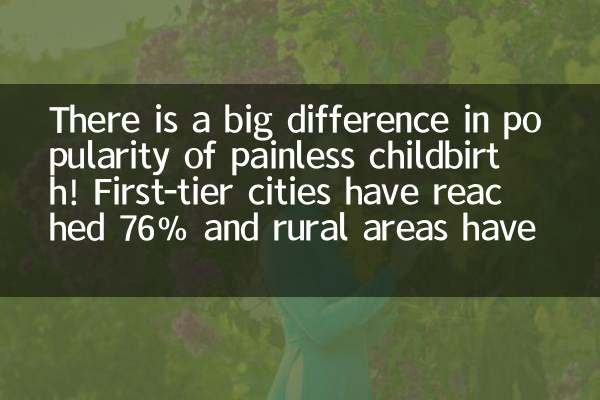There is a big difference in popularity of painless childbirth! First-tier cities have reached 76% and rural areas have less than 30%
In recent years, painless childbirth has gradually been recognized by the society as an important technology to relieve maternal pain. However, the latest data show that there are significant regional differences in the popularity of painless childbirth in my country, and the gap between first-tier cities and rural areas is particularly prominent. This article will combine hot data from the past 10 days to analyze the current popularity of painless childbirth in China and the reasons behind it.
According to statistics from the National Health Commission and some medical institutions, the popularity of painless childbirth in hospitals at all levels in 2023 is obviously stratified:

| area | Painless childbirth prevalence rate | Comparing growth in 2022 |
|---|---|---|
| First-tier cities (such as Beijing and Shanghai) | 76% | +8% |
| Second-tier cities (such as Chengdu and Wuhan) | 52% | +6% |
| Third- and fourth-tier cities | 35% | +4% |
| Rural areas | 28% | +3% |
As can be seen from the table, the penetration rate of painless childbirth in first-tier cities has reached nearly 80%, while in rural areas it is still less than 30%. This gap not only reflects the imbalance in the distribution of medical resources, but also exposes the shortcomings of primary medical services.
1.Uneven allocation of medical resources: Grade A hospitals in first-tier cities are concentrated, with sufficient anesthesia doctors, while there is a serious shortage of anesthesiologists in rural areas. According to statistics, the number of anesthesiologists per 10,000 people nationwide is 0.5, while that in rural areas it is only 0.2.
2.Economic factors affect: Painless delivery costs are usually between 2,000 and 5,000 yuan, and the medical insurance reimbursement ratio in some areas is lower, so rural families are under greater economic pressure.
3.Cognitive Differences: Urban residents have a high acceptance of painless childbirth, while rural areas still have the traditional concept of "being patient with pain when giving birth", and some mothers and families have doubts about the safety of anesthesia.
In response to this issue, experts call for:
Recently, the National Health Commission has launched the "Painless Delivery Plan to the Countryside", with the first batch of pilot projects covering 100 county hospitals, with the goal of increasing the rural penetration rate to 50% by 2025.
On social media, topics such as #Does painless childbirth should be popularized# and #Rural mothers need painless childbirth# have caused heated discussions. Most netizens support the promotion of painless childbirth, believing that this is an improvement in women's reproductive rights. However, some voices pointed out that both technical promotion and safety supervision are needed.
In the future, with the inclination of policies and the decline of technology, the urban-rural gap in painless childbirth is expected to gradually narrow. However, achieving full popularization still requires long-term efforts from the government, medical institutions and all sectors of society.
(Note: The data in this article are compiled from the National Health Commission, the China Maternal and Child Health Association and public reports, and the statistical period is October 2023.)

check the details

check the details